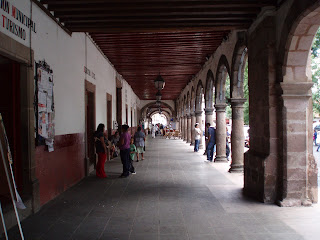Heading over from San Miguel, which was at its absolute driest and dustiest, with humidity in the single digits, to Morelia was a welcome change-of-pace, with rain clouds on the horizon and lush pine forests as we headed up (Pátzcuaro is at about 7400 feet). The scenery around Lake Pátzcuaro reminds me very much of Lake Atitlán in Guatemala, with shadows and light playing on volcanic mountains, the calm beauty of water and a tremendous richness of indigenous culture.
Pátzcuaro is the homeland of the Purhépecha Indians, and as with Oaxaca and Chiapas the strong presence of an indigenous culture means far greater cultural, artistic and culinary interest for visitors.
Pátzcuaro, while a small town compared to Morelia (population ~ 1 million), is the trading and commercial center for a string tiny villages surrounding the lake, each of which specializes in a particular craft, ranging from copper to mask-making and furniture. We were most interested in masks, and our friends Mark and Nancy knew just where to take us: the home of the renowned Orta family, master mask-makers who are multiple first-prize winners of Mexico's National Mask Maker competition. We bought a small piece but were sorely tempted by their larger works, which are as intricate in their craftsmanship and daring in their imaginitiveness as any art we've seen. Here are a couple of examples:
The town center is like a mini-Morelia, with porticos everywhere, two beautiful plazas and a very active café society that feels very European, with people meeting in outdoor venues for coffee and conversation at all hours.
The central mercado is so densely-packed and bustling you'd think you were in a much larger city, while the variety of produce and unbelievably low prices remind you that you're in Mexico's agricultural heartland. Check out the prices posted on this photo (remembering that they're per kilo - which is 2.2. pounds - and that the peso is currently at nearly 14 to the dollar):
Our friends who live here estimate the local expat population at around 300 people. We met a nice cross-section of that group at a birthday party and ran into others on the street and in cafés. As you might expect it's a crowd thick with artists and patrons of the arts, very progressive and seriously into learning more about Mexico and supporting indigenous cultures. The gated community and don't-speak-a-word-of-Spanish-don't-want-to sets so frequently encountered in places with large gringo populations are nowhere to be seen.
Now while Erin has a pretty high tolerance for Christian churches, I've seen enough bleeding Jesuses and dusty statues of the Virgin in Mexico to last me a lifetime (if I were a theist I'd want to be on the other side of the world, in Tantric India with its pantheon of sexy gods and goddesses). Being naturally subversive I tend to have more appreciation for the Mayan adaptation/usurpation of Christian elements into their native traditions, but I didn't know that in Mexico and throughout Latin America there's a special class of saint worship for the poor and the downtrodden, that neatly usurps Catholic imagery: the cult of Santa Muerte. We visited her shrine on the lake, and to say it was a wee bit creepy would be an understatement:
Entrance to the Sanctuary
The welcoming committee - no red-eye correction needed
This one could be from India's Kali cult - check out the human thighbone flute and human heart in a bowl. Simply charming.
The few days we spent in and around Pátzcuaro made us realize once again that Michoacán really is, as many Mexicans have said, the most complete representation of the country as a whole of any Mexican state. You have gorgeous deserted beaches, jungle, twelve thousand foot high peaks awash in Monarch butterflies, lakes and rivers, ancient indigenous cultures, modern cities with a thoroughly European feel and a depth and diversity of agriculture and cuisine that are unsurpassed.
Pátzcuaro itself is clearly a power spot - a mesmerizing place - and while it's too cold in the winter and has far too small of a gringo population to work for us as a home base it's a place we plan on returning to for extended visits whenever we get the chance.











